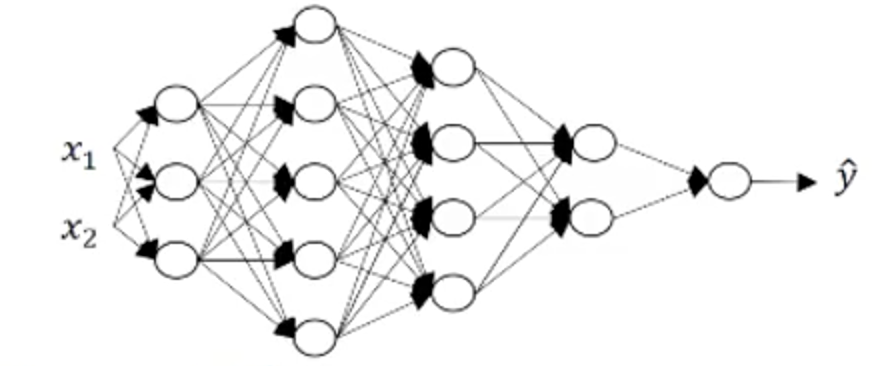
總算完成 deeplearning.ai 第一階段課程 “Neural Networks and Deep Learning”
真的相當有趣的基礎課程,基本上上完了就等於把o’reilly deep learning 的整本書都上完.並且有實際透過 numpy 寫完部分的 DNN 的分類器的作業.
起源
本來就想把 Deep Learning 學一下, 因緣際會下看到這一篇 Coursera 學習心得 試讀了七天,除了提供 Jupyter Notebook 之外,作業也都相當有趣,就開始繼續學了. 目前進度到 Week2 相當推薦有程式設計一點點基礎就可以來學.裡面的數學應該還好. 學習的過程中還可以學會 Python 裡面的 numpy 如何使用,因為裡面主要就是要教導你如何使用 numpy 來兜出 Neural Network .
課程鏈結: 這裡
學習鏈結:
- Week 1-2: Introduction to deep learning & Neural Networks Basics
- Week 3: Shallow neural networks
- Week 4: Deep Neural Networks
課程內容:
第四週: Deep Neural Networks
基本符號解釋:
- Deep Neural Network 的 Layer 數,不包括輸入層.有包括隱藏曾與輸出層.
- \(N^[l]\) 代表第幾層裡面的個數.
- \(X\) (輸入層) 通常也可以表示成 \(a^[0]\)
那麼簡單的式子可以表達成以下的方式:
\[Z^{[1]} = W^{[1]} * X + b^{[1]} \\ a^{[1]} = g^{[1]} * (Z^{[1]}) \\ Z^{[2]} = W^{[2]} * a^{[1]} + b^{[2]} \\ a^{[2]} = g^{[2]}*(Z^{[2]})\]…
其中別忘記 \(X -> a^{[0]}\)
透過這樣,可以簡化成:
\[Z^{[l]} = W^{[l]} \\ a^{[l-1]} + b^{[l]} \\ a^{[l]} = g^{[l]}(Z^{[2]})\]Where \(l = 1, 2, ... L\)
Hyperparameters
用來決定 \(w\) 與 \(b\) 的都算是 hyperparameter ,舉凡:
- Learning rate
- Hidden layer and hidden Unit
- Choice of activation function
關於 DNN 的 Layer 與 weight 的 shape

透過這張圖,其實有不少關於 Deep Neural Network 可以談的:
- 這個 NN 總共有 5 Layer,其中有 4 Layer 是 Hidden Layer.不包括輸入層.
- 每一層的 Neural 數為:
- A^0 = 2
- A^1 = 3
- A^2 = 5
- A^3 = 4
- A^4 = 2
- A^5 = 1
- 其中 W 的 shape 個數分別為:
- W1=(3,2)
- W2=(5,3)
- W3=(4,5)
- W4=(2,4)
- 推導出來表現方式為 \(W^l = dim(l, l-1)\)
\(W^l = dim(l, l-1)\) 舉個例子是:
推倒的式子為: Z1 = W1 * X + B1 [3,1] = W1 * X[2,1] + B1 (先假設 B1 = 0) => W1 * [2,1] = [3,1] => W1 –> [3, 2] –> [3, 2] * [2, 1] –> [3, 1] => W1 * X + B1 => B1.shape = W1*B1 = [3, 1]
總複習:
Init Parameter:
- Init \(W\) and \(B\)
- \(W\) could not be zero, because it is hard to moving to balance.
- shape:
- W1: (input hidden layer size, input layer size)
- WW: (output layer size, input hidden layer size)
- ((l-1)layer dim, l layer dim)
- shape:
- \(B\) suggest using zero for init values.
- shape:
- B1: (input hidden layer size, 1)
- B2: (output layer size, 1)
- shape:
Init deep parameters:
- You need init every layer (W, B) as well.
Linear forward:
- Caculate
Z= WX + b - Need cache parameter
cache = A, W, b - Need return
Z,cacheas wll
Linear Activation forward
use sigmoid or relu to transform your Z to activation (denoe: A).
use A_prev (A from previous layer) to get Z and transform to A.
L model forward
- Caculate each hidden layer with
reluactivation function. - Use
sigmoidas output layer activation
Compute cost
\[cost (J) = - 1/m \sum\limits_{i = 1}^{m} (y^{(i)}\log\left(a^{[L] (i)}\right) + (1-y^{(i)})\log\left(1- a^{[L](i)}\right))\]Backward propagation - Linear backward.
\[dAL = - (np.divide(Y, AL) - np.divide(1 - Y, 1 - AL))\]L-Model backward
\[dZ^{[l]} = dA^{[l]} * g'(Z^{[l]})\]Update parameters
\[W^{[l]} = W^{[l]} - \alpha \text{ } dW^{[l]} \\ b^{[l]} = b^{[l]} - \alpha \text{ } db^{[l]}\]
